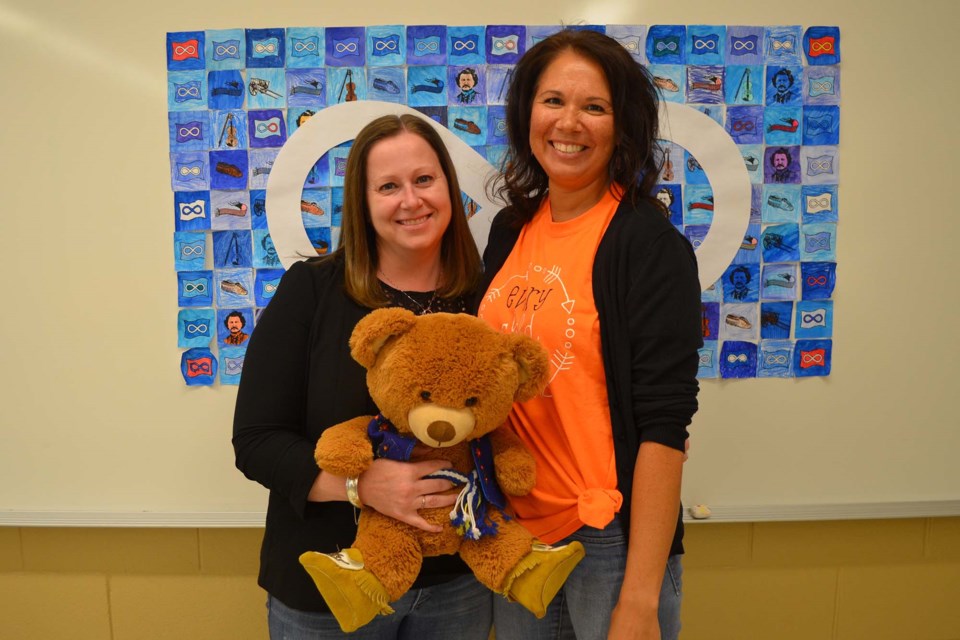It’s a classroom like no other.
There are no chairs and desks, but instead a circular rug grounding the space. The walls are complete with depictions of tall birch trees, a large medicine wheel, and a collaborative school project depicting the Métis flag. The energy in the room is calm, and relaxed.
“The classroom has not really changed in 100 years,” said Heather Friedenthal, a teacher at Sir Alexander Mackenzie Elementary School (SAM) and one of the classroom’s designers.
“We wanted a space where our Indigenous students would see themselves reflected but also our non-Indigenous students would see the importance of that reflection as well.”
Together, Friedenthal and her educational assistant (EA) Amy Watson, have worked to bring Indigenous teachings into the classroom in innovative ways.
Watson, who is a talented artist, contributes much of the art that makes the classroom stand out, such as the trees and medicine wheel.
Resting in the corner of the room is Asiniwaciy, the school’s Ambearrister. The Plains Cree name translates to Mountain, and was given by Elder Ernest Arcand during a naming ceremony the children of SAM participated in.
Friedenthal said involvement with members of the Indigenous community such as Arcand, Sharon Morin, and Celina Loyer, has been essential in crafting new activities for students.
Additionally, support from other staff at SAM and the St. Albert Public School division — especially deputy superintendent Marianne Barrett — has made all the difference in moving forward with innovative strategies.
“We could stand up at staff meetings and say, ‘This is a good idea,’ but if nobody is willing to do it in their classroom, it’s not going anywhere,” Friedenthal said. “At SAM, everyone has just jumped in.”
Other ventures Friedenthal and Watson have embarked on include teaching students how literature can perpetuate stereotypes by digging through representations in library books, as well as considering whether storytelling lessons can involve oral storytelling instead of focusing only on the written word.
Watson said teaching Indigenous topics well means incorporating Indigenous worldviews into as many lessons as possible, rather than relegating teaching Indigenous subject matter to one specific time of the year.
One goal of the duo’s work is to impart the ways that Indigenous ways of understanding and living are still in use today.
“Some teachings could just focus on the past,” Watson said. “But [Indigenous] people are still on this land; the culture is still thriving and beautiful.”
One key activity Watson and Friedenthal highlighted that SAM students have recently been a part of is called a “blanket exercise,” which helps to teach the shared history of Indigenous and non-Indigenous peoples in Canada.
Participants bring a blanket and lay down on the floor. Together, the blankets represent Turtle Island — a term used by some Indigenous peoples as a name for what is now called North America.
As the exercise goes on, the blankets get folded down to represent the land stolen by Europeans, and some participants sit off to the side to represent the loss of communities as colonization continues.
After the exercise, participants debrief to break down the topics they’ve just explored, and children are given an opportunity to express how they felt through the exercise, and what they might have learned.
“For many of them, it’s a very powerful experience,” Friedenthal said. “They are very attuned to justice, and so they’re able to see when something isn’t right, and they want to take action.”
That desire for action is channeled into other student activities, Friednethal said. For example, Grade 6 students who have begun learning about government have been engaged in writing letters to Prime Minister Justin Trudeau opposing the lack of drinkable water on reserves across Canada.
For Watson, who is Métis, some of the most exciting moments of the learning she has worked to foster are the real ways her culture is now being embraced.
Watson’s son wore his Métis sash to school the day students were participating in a blanket exercise, and was flocked by his peers who were impressed and interested.
“That’s not something that would happen when I was younger in school,” Watson said. “That’s what makes this work so amazing.”
As a settler, Friedenthal said one part of the work she and others in the community have been tackling includes understandings of privilege.
Instead of feeling shame, Friedenthal said it’s important to acknowledge how those in positions of privilege can help to affect change and “make sure that those doors are opening for everybody, that there aren’t some people who slam into a door while other people walk through a door they didn’t even know was there.”
As educators such as Friedenthal and Watson continue to innovate alongside coworkers and Indigenous community members, Friedenthal said it’s essential that Alberta’s curriculum supports the growth happening at schools.
Going forward, Friedenthal said she and Watson are excited to think about “how we can turn education on its head.”
“That doesn’t mean that … everything has to change,” Friedenthal said. “But we’re understanding that there are other ways to do things that have value as well.”
Bringing worldviews other than a classical Western one to the classroom is essential, she said.
“Kids would be better for it in the long run, and probably have much more tolerance in our adult society if that starts down here in elementary school.”



